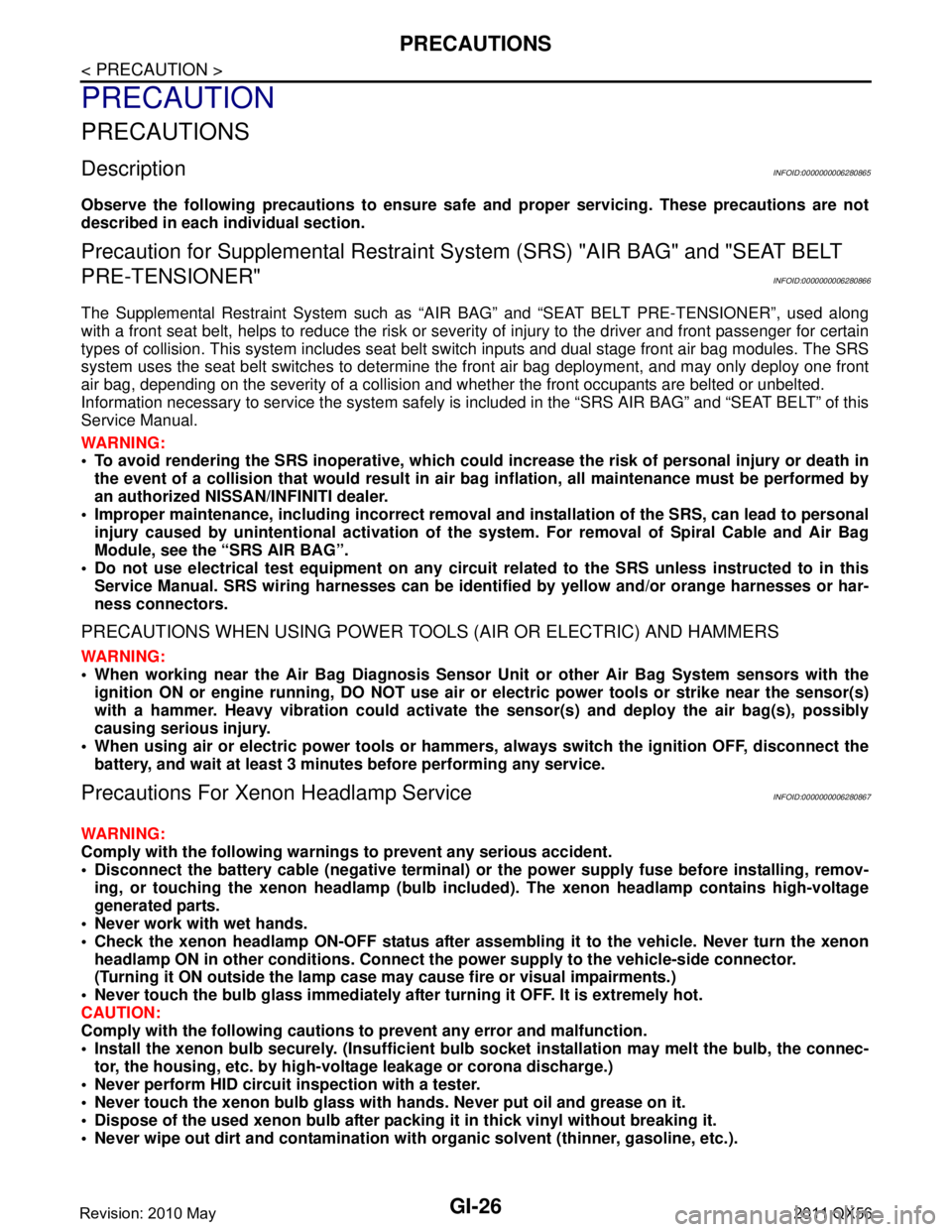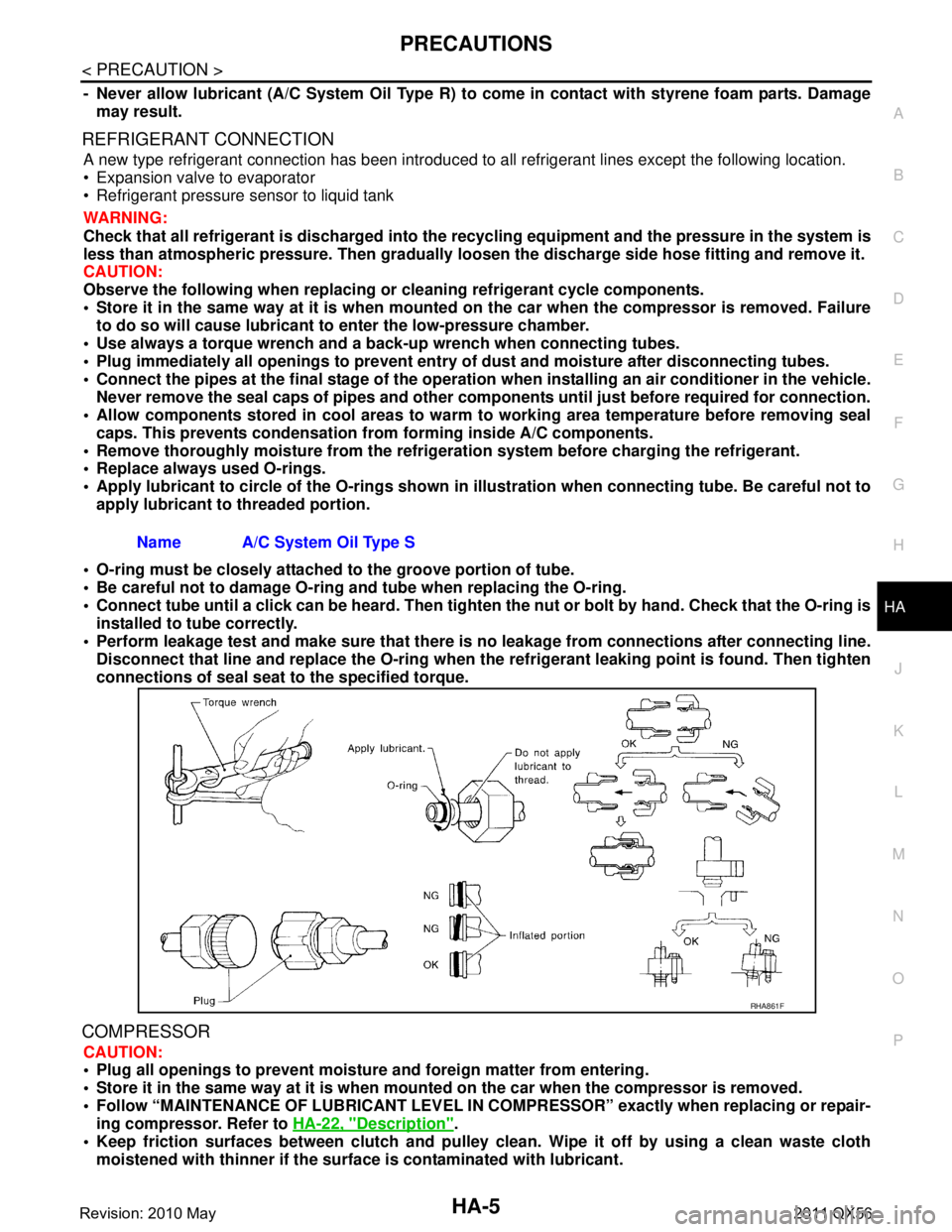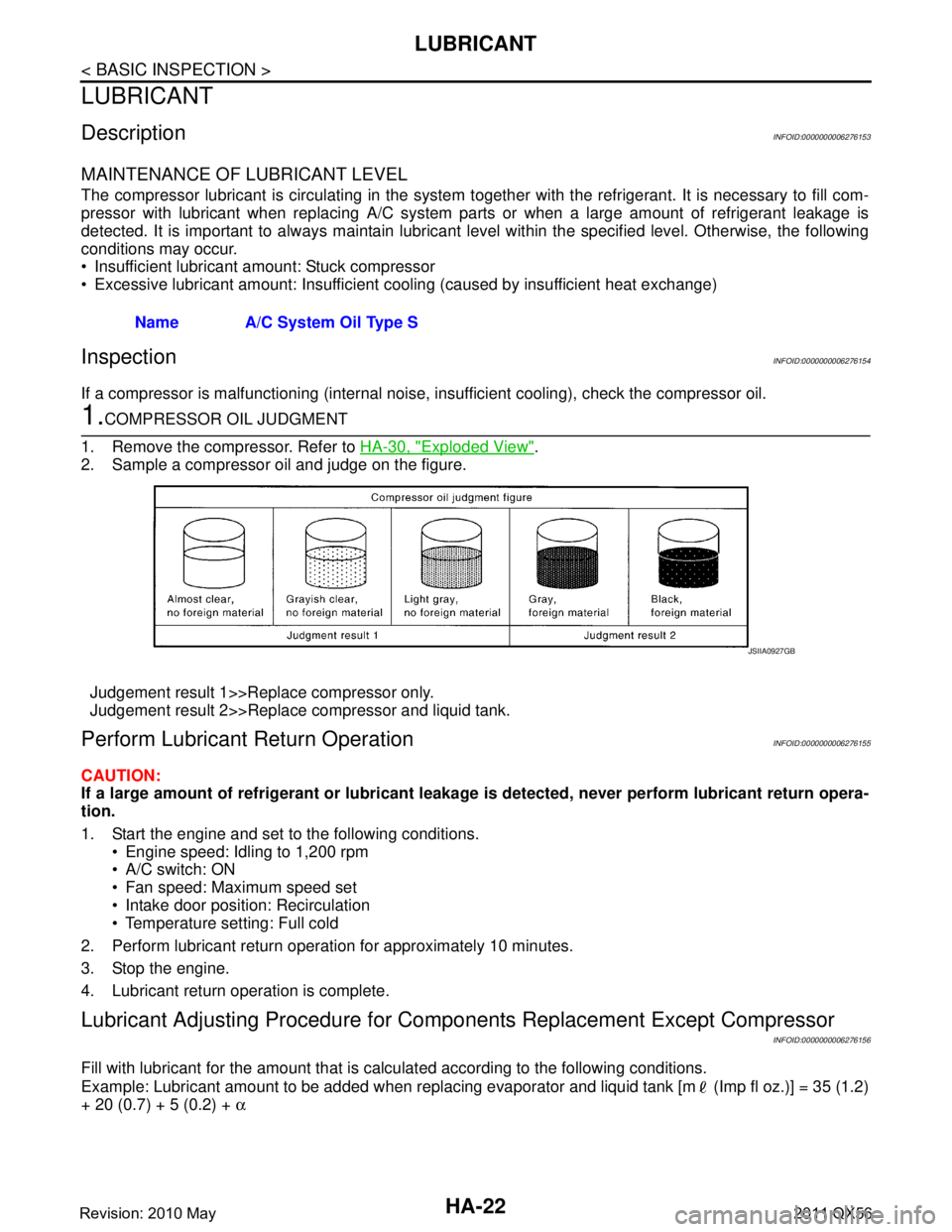2011 INFINITI QX56 oil type
[x] Cancel search: oil typePage 2838 of 5598
![INFINITI QX56 2011 Factory Service Manual
EXL-128
< REMOVAL AND INSTALLATION >[XENON TYPE]
FRONT FOG LAMP
FRONT FOG LAMP
Exploded ViewINFOID:0000000006369467
Removal and InstallationINFOID:0000000006369468
CAUTION:
Disconnect the battery neg INFINITI QX56 2011 Factory Service Manual
EXL-128
< REMOVAL AND INSTALLATION >[XENON TYPE]
FRONT FOG LAMP
FRONT FOG LAMP
Exploded ViewINFOID:0000000006369467
Removal and InstallationINFOID:0000000006369468
CAUTION:
Disconnect the battery neg](/manual-img/42/57033/w960_57033-2837.png)
EXL-128
< REMOVAL AND INSTALLATION >[XENON TYPE]
FRONT FOG LAMP
FRONT FOG LAMP
Exploded ViewINFOID:0000000006369467
Removal and InstallationINFOID:0000000006369468
CAUTION:
Disconnect the battery negative terminal or remove the fuse.
REMOVAL
1. Remove front fender protector. Refer to
EXT-23, "FENDER PROTECTOR : Removal and Installation".
2. Remove front fog lamp finisher.
3. Disconnect front fog lamp harness connector.
4. Remove front fog lamp fixing screw.
5. Disengage pawl, and then remove front fog lamp.
INSTALLATION
Install in the reverse order of removal.
NOTE:
After installation, perform aiming adjustment. Refer to EXL-123, "
Description".
ReplacementINFOID:0000000006369469
CAUTION:
Disconnect the battery negative terminal or remove the fuse.
Never touch the glass of bulb directly by hand. Keep grease an d other oily matters away from it.
Never touch bulb by hand while it is lit or right after being turned off.
Never leave bulb out of lamp reflector for a long ti me because dust, moisture smoke, etc. may affect
the performance of lamp. When replacing bulb, be sure to replace it with new one.
FRONT FOG LAMP BULB
1. Remove front fender protector. Keep the service area. Refer to EXT-23, "FENDER PROTECTOR :
Removal and Installation".
1. Front bumper 2. Front fog lamp 3. Front fog lamp finisher
: Pawl
JMLIA1117ZZ
Revision: 2010 May2011 QX56
Page 2850 of 5598
![INFINITI QX56 2011 Factory Service Manual
EXL-140
< REMOVAL AND INSTALLATION >[XENON TYPE]
HIGH-MOUNTED STOP LAMP
HIGH-MOUNTED STOP LAMP
Exploded ViewINFOID:0000000006369484
Removal and InstallationINFOID:0000000006369485
REMOVAL
1. Remove r INFINITI QX56 2011 Factory Service Manual
EXL-140
< REMOVAL AND INSTALLATION >[XENON TYPE]
HIGH-MOUNTED STOP LAMP
HIGH-MOUNTED STOP LAMP
Exploded ViewINFOID:0000000006369484
Removal and InstallationINFOID:0000000006369485
REMOVAL
1. Remove r](/manual-img/42/57033/w960_57033-2849.png)
EXL-140
< REMOVAL AND INSTALLATION >[XENON TYPE]
HIGH-MOUNTED STOP LAMP
HIGH-MOUNTED STOP LAMP
Exploded ViewINFOID:0000000006369484
Removal and InstallationINFOID:0000000006369485
REMOVAL
1. Remove rear spoiler. Refer to
EXT-41, "Removal and Installation".
2. Remove high-mounted stop lamp mounting screws.
3. Remove high-mounted stop lamp cover, and then remove high-mounted stop lamp.
INSTALLATION
Install in the reverse order of removal.
1. Rear spoiler 2. High-mounted stop lamp 3. High-mounted stop lamp cover
JMLIA0985ZZ
Revision: 2010 May2011 QX56
Page 2852 of 5598
![INFINITI QX56 2011 Factory Service Manual
EXL-142
< REMOVAL AND INSTALLATION >[XENON TYPE]
BACK-UP LAMP
Replacement
INFOID:0000000006369488
CAUTION:
Disconnect the battery negative terminal or remove the fuse.
Never touch the glass of bu INFINITI QX56 2011 Factory Service Manual
EXL-142
< REMOVAL AND INSTALLATION >[XENON TYPE]
BACK-UP LAMP
Replacement
INFOID:0000000006369488
CAUTION:
Disconnect the battery negative terminal or remove the fuse.
Never touch the glass of bu](/manual-img/42/57033/w960_57033-2851.png)
EXL-142
< REMOVAL AND INSTALLATION >[XENON TYPE]
BACK-UP LAMP
Replacement
INFOID:0000000006369488
CAUTION:
Disconnect the battery negative terminal or remove the fuse.
Never touch the glass of bu lb directly by hand. Keep grease an d other oily matters away from it.
Never touch bulb by hand while it is lit or right after being turned off.
Never leave bulb out of lamp reflector for a long ti me because dust, moisture smoke, etc. may affect
the performance of lamp. When replacing bulb, be sure to replace it with new one.
TAIL LAMP BULB
1. Remove lamp mask. Refer to INT-39, "Exploded View".
2. Disconnect tail lamp connector.
3. Tail bulb socket counterclockwise and unlock it.
4. Remove bulb from bulb socket.
BACK-UP LAMP BULB
1. Remove lamp mask. Refer to INT-39, "Exploded View".
2. Disconnect back-up lamp connector.
3. Turn bulb socket counterclockwise and unlock it.
4. Remove bulb from bulb socket.
Revision: 2010 May2011 QX56
Page 2853 of 5598
![INFINITI QX56 2011 Factory Service Manual
LICENSE PLATE LAMPEXL-143
< REMOVAL AND INSTALLATION > [XENON TYPE]
C
D
E
F
G H
I
J
K
M A
B
EXL
N
O P
LICENSE PLATE LAMP
Exploded ViewINFOID:0000000006369489
Removal and InstallationINFOID:0000000006 INFINITI QX56 2011 Factory Service Manual
LICENSE PLATE LAMPEXL-143
< REMOVAL AND INSTALLATION > [XENON TYPE]
C
D
E
F
G H
I
J
K
M A
B
EXL
N
O P
LICENSE PLATE LAMP
Exploded ViewINFOID:0000000006369489
Removal and InstallationINFOID:0000000006](/manual-img/42/57033/w960_57033-2852.png)
LICENSE PLATE LAMPEXL-143
< REMOVAL AND INSTALLATION > [XENON TYPE]
C
D
E
F
G H
I
J
K
M A
B
EXL
N
O P
LICENSE PLATE LAMP
Exploded ViewINFOID:0000000006369489
Removal and InstallationINFOID:0000000006369490
CAUTION:
Disconnect the battery negative terminal or remove the fuse.
REMOVAL
1. Remove back door trim. Refer to INT-39, "Removal and Installation".
2. Disconnect license plate lamp connector.
3. Remove back door finisher center upper.
4. Remove license plate lamp while pushing a resin clip, and then remove license plate lamp.
INSTALLATION
Install in the reverse order of removal.
ReplacementINFOID:0000000006369491
CAUTION:
Disconnect the battery negative terminal or remove the fuse.
Never touch the glass of bulb directly by hand. Keep grease and other oily matters away from it.
Never touch bulb by hand while it is lit or right after being turned off.
Never leave bulb out of lamp reflector for a long time because dust, moisture smoke, etc. may affect
the performance of lamp. When replacing bu lb, be sure to replace it with new one.
LICENSE PLATE LAMP BULB
1. Remove back door trim. Refer to INT-39, "Removal and Installation".
2. Disconnect license plate lamp connector.
1. License plate lamp harness 2. License plate lamp bulb socket 3. License plate lamp bulb
4. License plate lamp 5. Back door finisher center upper
JMLIA1122ZZ
Revision: 2010 May2011 QX56
Page 2990 of 5598

GI-26
< PRECAUTION >
PRECAUTIONS
PRECAUTION
PRECAUTIONS
DescriptionINFOID:0000000006280865
Observe the following precautions to ensure safe and proper servicing. These precautions are not
described in each individual section.
Precaution for Supplemental Restraint S ystem (SRS) "AIR BAG" and "SEAT BELT
PRE-TENSIONER"
INFOID:0000000006280866
The Supplemental Restraint System such as “A IR BAG” and “SEAT BELT PRE-TENSIONER”, used along
with a front seat belt, helps to reduce the risk or severi ty of injury to the driver and front passenger for certain
types of collision. This system includes seat belt switch inputs and dual stage front air bag modules. The SRS
system uses the seat belt switches to determine the front air bag deployment, and may only deploy one front
air bag, depending on the severity of a collision and w hether the front occupants are belted or unbelted.
Information necessary to service the system safely is included in the “SRS AIR BAG” and “SEAT BELT” of this
Service Manual.
WARNING:
To avoid rendering the SRS inopera tive, which could increase the risk of personal injury or death in
the event of a collision that would result in air bag inflation, all maintenance must be performed by
an authorized NISS AN/INFINITI dealer.
Improper maintenance, including in correct removal and installation of the SRS, can lead to personal
injury caused by unintent ional activation of the system. For re moval of Spiral Cable and Air Bag
Module, see the “SRS AIR BAG”.
Do not use electrical test equipmen t on any circuit related to the SRS unless instructed to in this
Service Manual. SRS wiring harnesses can be identi fied by yellow and/or orange harnesses or har-
ness connectors.
PRECAUTIONS WHEN USING POWER TOOLS (AIR OR ELECTRIC) AND HAMMERS
WARNING:
When working near the Air Bag Diagnosis Sensor Unit or other Air Bag System sensors with the
ignition ON or engine running, DO NOT use air or electric power tools or strike near the sensor(s)
with a hammer. Heavy vibration could activate the sensor(s) and deploy the air bag(s), possibly
causing serious injury.
When using air or electric power tools or hammers , always switch the ignition OFF, disconnect the
battery, and wait at least 3 minu tes before performing any service.
Precautions For Xenon Headlamp ServiceINFOID:0000000006280867
WARNING:
Comply with the following warnings to prevent any serious accident.
Disconnect the battery cable (negative terminal) or the power supply fuse before installing, remov-
ing, or touching the xenon headlamp (bulb included). The xenon headlamp contains high-voltage
generated parts.
Never work with wet hands.
Check the xenon headlamp ON-OFF status after assembling it to the vehicle. Never turn the xenon
headlamp ON in other conditions. Connect th e power supply to the vehicle-side connector.
(Turning it ON outside the lamp case m ay cause fire or visual impairments.)
Never touch the bulb glass immediately after turning it OFF. It is extremely hot.
CAUTION:
Comply with the following cautions to prevent any error and malfunction.
Install the xenon bulb securely. (Ins ufficient bulb socket installation may melt the bulb, the connec-
tor, the housing, etc. by high-v oltage leakage or corona discharge.)
Never perform HID circuit in spection with a tester.
Never touch the xenon bulb glass with ha nds. Never put oil and grease on it.
Dispose of the used xenon bulb after packing it in thick vinyl without breaking it.
Never wipe out dirt and cont amination with organic solven t (thinner, gasoline, etc.).
Revision: 2010 May2011 QX56
Page 3061 of 5598

PRECAUTIONSHA-5
< PRECAUTION >
C
DE
F
G H
J
K L
M A
B
HA
N
O P
- Never allow lubricant (A/C System Oil Type R) to come in contact with styrene foam parts. Damage
may result.
REFRIGERANT CONNECTION
A new type refrigerant connection has been introduced to a ll refrigerant lines except the following location.
Expansion valve to evaporator
Refrigerant pressure sensor to liquid tank
WARNING:
Check that all refrigerant is discharged into the recycling equipment and the pressure in the system is
less than atmospheric pressure. Then gradually loo sen the discharge side hose fitting and remove it.
CAUTION:
Observe the following when replacing or cleaning refrigerant cycle components.
Store it in the same way at it is when mounted on the car when the compressor is removed. Failure
to do so will cause lubricant to enter the low-pressure chamber.
Use always a torque wrench and a b ack-up wrench when connecting tubes.
Plug immediately all openings to prevent entry of dust and mois ture after disconnecting tubes.
Connect the pipes at the final stag e of the operation when installing an air conditioner in the vehicle.
Never remove the seal caps of pipes and other compon ents until just before required for connection.
Allow components stored in cool areas to warm to working area temperature before removing seal
caps. This prevents condensation from forming inside A/C components.
Remove thoroughly moisture from the refriger ation system before charging the refrigerant.
Replace always used O-rings.
Apply lubricant to circle of th e O-rings shown in illustration when connecting tube. Be careful not to
apply lubricant to threaded portion.
O-ring must be closely attached to the groove portion of tube.
Be careful not to damage O-ring and tube when replacing the O-ring.
Connect tube until a click can be heard. Then tighten the nut or bolt by hand. Check that the O-ring is
installed to tube correctly.
Perform leakage test and make sure that there is no leakage from connections after connecting line.
Disconnect that line and replace the O-ring when the refrigerant leaking point is found. Then tighten
connections of seal seat to the specified torque.
COMPRESSOR
CAUTION:
Plug all openings to prevent moisture and foreign matter from entering.
Store it in the same way at it is when moun ted on the car when the compressor is removed.
Follow “MAINTENANCE OF LUBRICANT LEVEL IN CO MPRESSOR” exactly when replacing or repair-
ing compressor. Refer to HA-22, "
Description".
Keep friction surfaces between clutch and pulley cl ean. Wipe it off by using a clean waste cloth
moistened with thinner if the surface is contaminated with lubricant.
Name A/C System Oil Type S
RHA861F
Revision: 2010 May2011 QX56
Page 3068 of 5598

HA-12
< PREPARATION >
PREPARATION
Commercial Service Tool
INFOID:0000000006276518
Sealant or/and LubricantINFOID:0000000006276143
HFC-134a (R-134a) Service Tool and Equipment
Never mix HFC-134a (R-134a) refrigerant and/or its s pecified lubricant with CFC-12 (R-12) refrigerant and/
or its lubricant.
Separate and non-interchangeable service equipment must be used for handling each type of refrigerant/ lubricant.
Refrigerant container fittings, service hose fittings and service equipment fittings (equipment which handles
refrigerant and/or lubricant) are different between CF C-12 (R-12) and HFC-134a (R-134a). This is to avoid
mixed use of the refrigerants/lubricant.
Never use adapters that convert one size fitting to another: refrigerant/lubricant contamination occurs and
compressor malfunction may result.
Tool name Description
Refrigerant identifier equipment Checking for refrigerant purity and
system contamination
Power tools For loosening bolts and nuts
RJIA0197E
PBIC0190E
Tool name Description
HFC-134a (R-134a) refrigerant Container color: Light blue
Container marking: HFC-134a (R-
134a)
Fitting size: Thread size
Large container 1/2
″-16 ACME
A/C System Oil Type S (DH-PS) Type: Polyalkylene glycol oil (PAG),
type S (DH-PS)
Application:
HFC-134a (R-134a) swash plate com-
pressors
Capacity: 40 m (1.4 Imp fl oz.)
S-NT196
S-NT197
Revision: 2010 May2011 QX56
Page 3078 of 5598

HA-22
< BASIC INSPECTION >
LUBRICANT
LUBRICANT
DescriptionINFOID:0000000006276153
MAINTENANCE OF LUBRICANT LEVEL
The compressor lubricant is circulating in the system together with the refrigerant. It is necessary to fill com-
pressor with lubricant when replacing A/C system pa rts or when a large amount of refrigerant leakage is
detected. It is important to always maintain lubricant level within the specified level. Otherwise, the following
conditions may occur.
Insufficient lubricant amount: Stuck compressor
Excessive lubricant amount: Insufficient cooling (caused by insufficient heat exchange)
InspectionINFOID:0000000006276154
If a compressor is malfunctioning (internal noise, insufficient cooling), check the compressor oil.
1.COMPRESSOR OIL JUDGMENT
1. Remove the compressor. Refer to HA-30, "
Exploded View".
2. Sample a compressor oil and judge on the figure.
Judgement result 1>>Replace compressor only.
Judgement result 2>>Replace compressor and liquid tank.
Perform Lubricant Return OperationINFOID:0000000006276155
CAUTION:
If a large amount of refrigerant or lubricant leakag e is detected, never perform lubricant return opera-
tion.
1. Start the engine and set to the following conditions.
Engine speed: Idling to 1,200 rpm
A/C switch: ON
Fan speed: Maximum speed set
Intake door position: Recirculation
Temperature setting: Full cold
2. Perform lubricant return operation for approximately 10 minutes.
3. Stop the engine.
4. Lubricant return operation is complete.
Lubricant Adjusting Procedure for Comp onents Replacement Except Compressor
INFOID:0000000006276156
Fill with lubricant for the amount that is calculated according to the following conditions.
Example: Lubricant amount to be added when replacing evapor ator and liquid tank [m (Imp fl oz.)] = 35 (1.2)
+ 20 (0.7) + 5 (0.2) + α
Name A/C System Oil Type S
JSIIA0927GB
Revision: 2010 May2011 QX56